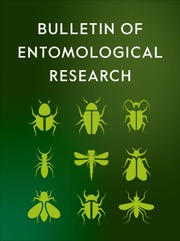No CrossRef data available.
Article contents
Fluffy bums and their aliens: Passionvine hoppers (Scolypopa australis (Walker)) and their elusive parasitoid wasps
Published online by Cambridge University Press: 26 March 2025
Abstract
Hymenopteran parasitoids are an understudied group of insects despite being important in biological control programs globally. Little is known about the ability of parasitoids to control the passionvine hopper (Scolypopa australis (Walker); PVH), which was introduced to New Zealand (NZ) in the 1800s and has since become a major economic pest of kiwifruit. However, in their native Australia, this species has not reached pest status, likely due to the presence of associated parasitoids. Understanding the ecology of parasitoids associated with PVH in their native range is a critical step in identifying potential biological control agents that could be used in NZ. In this study, PVH presence and occupancy on different plant species was determined and the PVH parasitoid fauna of NZ compared with the Australian fauna. Collections were undertaken in and around Melbourne, Australia, between December 2021 and May 2023 in public and private gardens, roadside verges and parklands. Parasitoids were reared from the nymphs and eggs of PVH and identified. Ten species of parasitoid were discovered to parasitise PVH, eight of which were new host records. Three parasitoids, Dryinus koebelei, Neodryinus nelsoni, and Neodryinus koebelei, were reared from PVH nymphs and seven parasitoids were reared from PVH eggs: Ablerus sp., Anastatus sp., Centrodora sp., Cheilonoeurus sp., Ooencyrtus sp., and unknown species belonging to the families Figitidae and Platygastridae. These new data have made a significant contribution to understanding the ecology of PVH in their native range.
- Type
- Research Paper
- Information
- Copyright
- © The Author(s), 2025. Published by Cambridge University Press.



